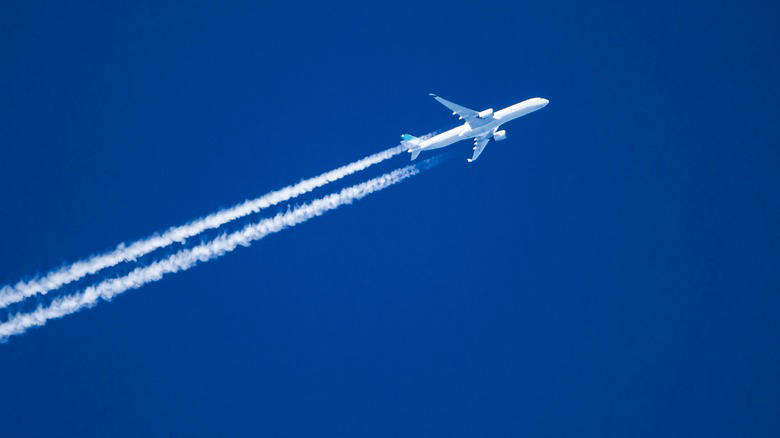The Surprising Origins Of Those White Lines Airplanes Leave Behind

Gaze up at the sky on any clear day and you’ll likely see it streaked with the white lines left behind from jets as they pass overhead on their way to destinations all over the world. Sometimes, you may see them fade almost immediately as the airplane moves out of eyesight. Other times, they hover in the sky, growing larger. Occasionally, the entire sky becomes a grid of these strange smokey clouds. You may have heard conspiracy theorists on social media refer to them as chemtrails, but they’re actually called contrails. If you’ve caught yourself wondering what exactly causes them, and whether there is any validity to the chemtrail conspiracy theories, you’re certainly not alone.
The conspiracy theories around contrails have been around for a while, but recently they’ve been gaining popularity thanks to certain influencers fond of spreading misinformation online. According to the theories, “chemtrails” are the result of someone (in most cases the blame is placed on the government) spraying harmful chemicals from airplanes for all sorts of nefarious purposes. Some believe they are part of an elaborate plan to control the weather, while others claim they are to control or reduce the population.
In an age where anyone can gain traction and spread their opinions online, it’s more important than ever to rely on hard science and trust the experts. According to aviation experts and meteorologists contrails are simply condensation. They’re basically clouds that form when hot air and exhaust from the jet engine combustion collide with the cooler air at flight altitude. If you’re still not convinced, read on to learn all about the science behind contrails, and their effects.
Read more: 50 Weird Travel Facts You Should Know
Contrail Formation
When jet fuel burns it produces some by-products that are released into the atmosphere which include water vapor and tiny exhaust particles. When these substances hit the cold air at altitude, they freeze into ice crystals. Natural clouds are pretty much the same thing — frozen ice crystals hovering in the atmosphere.
Sometimes, the condensation trails quickly fade away, while other times they linger. The amount of time it takes for a contrail to dissipate is dependent on the humidity. A weird travel fact is that if you’re observant, you can sometimes predict the weather from contrails. When humidity is low, the contrails fade quickly. On cold, high humidity days the contrails will stick around and often grow wider and resemble cirrus clouds. Cirrus clouds can only occur at very high altitudes, which further debunks the “chemtrail” conspiracy theories. The contrails are so high in the sky, that it would be nearly impossible for them to drop all the way to earth.
Not all aircraft produce contrails. Only jets are able to fly high into the coldest parts of the atmosphere where conditions are right to create the condensation. Contrails form between elevations of 32,000 to 45,000 feet which coincides with the “cruise” altitude of jets. In the right conditions, contrails can grow to a length of several miles and stick around for hours.
Are Contrails Harmful?
Conspiracy theories are often based on some piece of historical evidence. In the case of contrails, the theories originated following government tests that took place in the 1950s and 60s in the United Kingdom. During that time, Britain was sprayed with chemicals as part of the secret experiments relating to biological warfare. Similarly, San Francisco was sprayed with chemicals in the 1950s to test the effects of bio weapon attacks. The experiments did not continue, and there is no evidence that contrails are made up of anything besides the by-products of jet fuel. That being said, they aren’t entirely harmless.
On one point, conspiracy theorists may be closer to the truth than they might think. It’s no secret that airplanes aren’t the most eco-friendly method of transportation. In a way, contrails are affecting the weather. They may be contributing to climate change, which many of the same conspiracy theorists believe is a myth. The ice crystals that make up contrails can trap heat, contributing to a warming climate. A study in 2011 found that contrails contribute to a warming atmosphere more than all of the carbon emissions from aviation, and the problem is only expected to get worse as flight frequency continues to increase around the world. So, while contrails don’t directly harm humanity with toxic chemicals as some continue to believe, in the long term they will affect the entire world by contributing to global climate change. Scientists believe that reducing airplane soot emission may help to decrease contrails. For more information on how to make your flight more sustainable, check out TSA’s top tips.
Read the original article on Explore.


